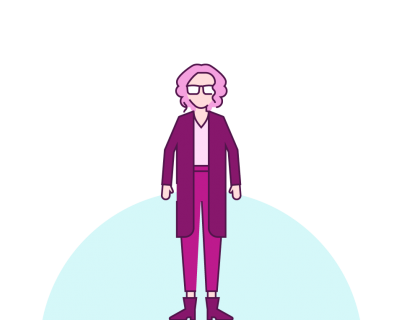How to level-up your presentation visuals
- Visual communication
- Comments: 2
Relationships are everywhere and if you can crack how to show relationships effectively on your slides then you’ll have your audience swiping right instead of left.

Audiences are more distracted than ever, so to compensate, content – in whatever form, whether it be articles, videos, university lectures, or even text messages – is becoming bite-size. So how can we create content that will keep audiences engaged? Here are ten tips that apply to everything from sales presentations given face-to-face to online learning modules where your audience is sat at home with a cup of tea.
If you look at a lot of the mainstream written content on the internet compared to ten years ago, you’ll notice paragraphs are far shorter than they used to be. Subtitles and headings are far more prevalent, and generally there’s just less information. As content consumers we’re just not used to trawling through 1,500 words to find out the latest news headlines.
And this doesn’t just apply to written information, it applies to presentations too. When writing your presentation if you find that you’re regularly writing paragraphs over 100 words, then you should really consider splitting them out into smaller sections.
So if you have your less-than-100-word bites, you can start grouping them into slides and then again into clicks for slides. Not using animations, or putting too much information on a slide in one go is like telling TV fans how the story ends at the beginning of the episode; they’re not as tuned into what you’re saying because they think they’ve worked it out (even if they haven’t): there’s nothing for them to interact with.
Use clicks and animations to pace your information. Force your audience to keep paying attention by not telling them your punchline too soon.
If you do this your visuals and your speaker will be working together in harmony. We’ve done quite a bit of research on this and we’ve found that putting text on a slide and then talking while the audience is trying to read is ineffective, as you read and listen with the same part of your brain.
But if you switch to using more visuals, you’re using a different part of your brain so because you’re using more of your brain you’re more likely to remember what you’re seeing as you’ve engaged with it on a deeper level. We call this visualisation, and you can learn more about it here.
But any amount of bite-size content split out intuitively and delivered well won’t make any difference if the content isn’t relevant to your audience. In sales presentations you should constantly ask yourselves if your content is answering the ‘why does this matter to me’ question. A history of your company may be interesting, but it’s not really succinctly telling me why I should pay attention.
Similarly if you’re delivering training content make sure your content is tailored to your audience. If you find that you’re having to include material that will end up being irrelevant to great swathes of attendees, cut your losses and run two sessions.
Tailoring your content will help you give the right information to the right people. The next step is to engage them on a more personal level. If an audience member can identify with your perspectives, empathise with what you’re saying, and breathe a sigh of relief to know they’re not the only one that thinks like that, then you’ll have built up some common ground and created an ally in that person.
We latch onto stories, look for faces in inanimate objects, and relate what we hear to our own personal experiences. If you weave this way of delivering information into your presentations you’ll notice that your audience is a lot more interested with what you have to say.
But that doesn’t mean a ten-minute long story and a selection of funny videos from YouTube. Be overt – don’t try to emotionally manipulate your audience, they won’t thank you for that. Be brief – time is precious and recognising that will win you points with your audience.
This is particularly relevant when the content isn’t being delivered ‘live’ by a presenter. We respond to rhythms and patterns. Rhythms and patterns help us to remember things, so when you’re asking someone to click through content with little or no narration, and no presenter to point out things and shift your attention, creating ways to make your content more interesting and memorable is key.
Think about how you flick through pictures, or scroll down a news feed – you get into a rhythm where you scroll at the same rate no matter how much content you’re actually taking in. You can make this work in your favour. You can create a rhythm just by putting a similar amount of content on a slide, and similarly you can stop the rhythm to draw particular attention to something. (You’d this by having a very small amount of content on a slide rather than having a lot.)
Recurring themes, ideas, and character also help things to stick in our minds and keep us engaged. This is why in our sales presentation we have what’s called a value proposition which shows the key benefits as well as progress through the presentation; the fact we keep repeating it makes the points easier to remember.
You can apply this to lots of different aspects of sales presentations, but this is particularly useful for training and elearning content. Repeating ideas, pulling familiar threads, and showing how different circumstances affect a recurring character will help give your audience something familiar to latch on to. Introduce them to an idea or a character and subsequent explanations become easier and shorter.
This also applies to associations. This can be anything from using familiar associations – think companies fitting together as well as jigsaw pieces – to using popular culture references to reference a concept you’re trying to explain.
We notice things that are familiar and so we’re more likely to pay attention as well as remember them after the fact.
You may have opinions about the fact our attention spans are getting shorter and that society is degrading because if anything takes longer to say than a Tweet we’re not interested in hearing it. But! Don’t try and change your audience. Acknowledge that they probably can’t cope with too much information in one go, don’t try and train them otherwise.
If you’re trying to be an attention span evangelist then you’ll most likely turn off your audience. You shouldn’t glumly accept your fate of presenting to people who will only pay attention if there’s a commercial break every ten minutes, but adapt your content to the needs of your audience so that it’s relevant, well-presented, relevant and consumable it in bite-size chunks.
Leave a commentRelationships are everywhere and if you can crack how to show relationships effectively on your slides then you’ll have your audience swiping right instead of left.
As humans we find stories incredibly compelling, but why is that? And how can we make sure we're infusing storytelling in our presentations to keep our audiences engaged and invested? Read on to find out the rest of the story!
In our information-rich world, we like to gorge ourselves on data. There are stats and facts for just about any topic you can imagine, just a Google search away. But are data on their own informative enough? When you’re presented with a wall of numbers, are you able to easily decipher the context, background and ramifications of all that information? Probably not – which is why data visualization is becoming increasingly important.
Join the BrightCarbon mailing list for monthly invites and resources
Tell me more!We have other people in our own business reaching out to say this is the best presentation they have seen.
Sarah Walker Softchoice

Excellent points here!
Thanks for the Post!